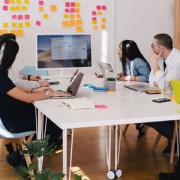While early references to design thinking have been around since the 1950s, the framework truly became relevant to business in the 1990s when David Kelley founded IDEO, a consulting company that applied a human-centric approach to designing better physical products. According to Tim Brown, President and CEO of IDEO, “Design thinking is a human-centered approach to innovation that draws from the designer’s toolkit to integrate the needs of people, the possibilities of technology and the requirements of business success.” Today, the company leverages this methodology to create positive change within complex systemic challenges, from healthcare to education.
For decades, designers have used design thinking to develop products or services, but only in the last decade has the wider business community applied the approach. From product development to customer experience to digital transformation, the application of design thinking has proven to have significant impact. It is a process that revolves around people and user needs, ideating to meet those needs, and developing products and solutions that are both impactful and sustainable. Design thinking also instills a collaborative and experimental attitude within the organization.
Many organizations have interpreted the design approach using their own terminology, but for the purposes of this Advisor, we will use IDEO’s language. The three overarching themes of the process are inspiration, ideation, and implementation:
- Inspiration. People, from customers to employees, are at the heart of the design process. The process should aim to capture their true motivations, better understand their challenges, and offer inspiration from their stories.
- Ideation. Do not limit yourself to what has worked in the past. Instead, explore audacious ideas to solve wicked problems, as we explored in our recent Executive Update.
- Implementation. This involves the process of building prototypes, testing hypotheses, getting feedback, and iterating the idea, so that you either fail fast or build solutions that have been validated and codeveloped by the user.
To illustrate these themes further, we have broken them down into the following six key steps: frame a question, gather inspiration, generate ideas, make ideas tangible, test to learn, and share the story.
1. Frame a Question
Identifying the question we are looking to answer is the first step in the process. The question or problem statement determines the approach to the solution, and it becomes a guiding force throughout the process. To help generate better outcomes, a question or problem statement is usually framed in the following way: “How might we…?“
For example, if we encountered an issue with the brakes on an automobile, our initial problem statement might be: “How can the brakes supplied to the automobile maker be improved?” But after more thoughtful consideration, we might frame the question as: “How might we improve safety in an automobile’s stopping system?” This framing expands our review to the whole ecosystem, potentially leading to more innovative, cost-effective, or holistic solutions.
2. Gather Inspiration
Our aim here is to obtain a better understanding of the people or problem and discover users’ unmet needs. We can achieve this through empathy — putting ourselves in someone else’s shoes — so that we see the world through their eyes, developing a deeper connection and not judging them. Synthesizing these findings leads to insights, which are the foundation of the design process. Some empathy-generating activities include the following:
- Observation — learn what people do in their natural environments.
- Interviews — better understand emotions, motivations, and challenges.
- Immersion — immerse oneself in the context of one’s subject (e.g., Walt Disney, when developing Disneyland, would kneel down to understand a child’s perspective).
- Journey mapping — create a timeline of the user journey that helps visualize pain points and emotions to better understand the user’s experience.
3. Generate Ideas
This is the phase in the process where we push past assumptions to get to the breakthrough ideas. There are many techniques to generate ideas, and as our primary goal is to generate volume, we defer judgment, looking for as many wild ideas as possible. Six Thinking Hats, mind mapping, and word associations are a few brainstorming tools to consider. Once we have generated a long list of ideas, we group and filter them.
4. Make Ideas Tangible
This is the process where we create low-fidelity prototypes, such as story boards, role playing, or wire framing, to bring ideas to life.
5. Test to Learn
We prototype so that we can present and test ideas to gain timely feedback in order to build on the idea or make changes to it with the help of customers — our users. The goal is to refine the ideas by gathering feedback and experimenting forward. We should do this quickly and iteratively, to better understand what works or what does not.
6. Share the Story
By sharing results, whether positive or negative, we create a learning environment that inspires organizations and people to continue to take action. Stories help ease the tasks inherent when implementing solutions because they create a sense of authenticity.
[For more from the authors on this topic, see “Digital Transformation & Design Thinking, Part II: A Closer Look at the Method.”]




